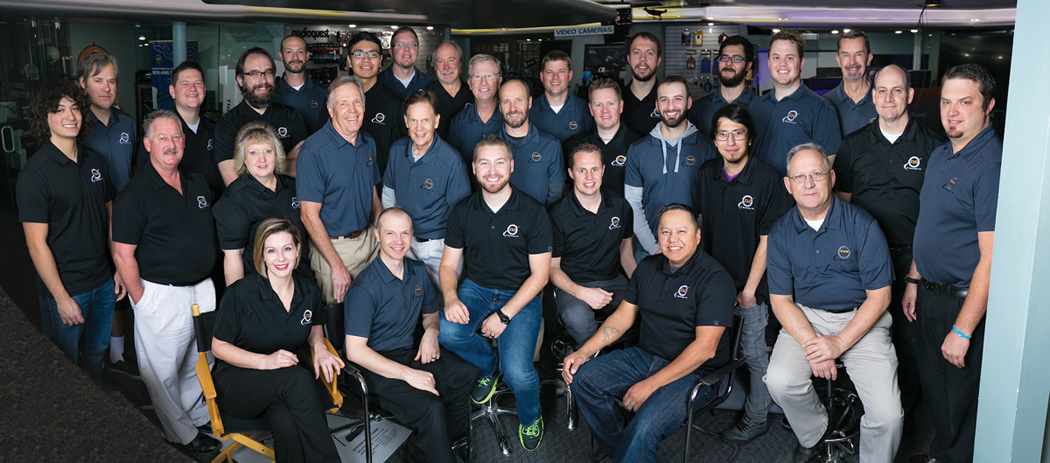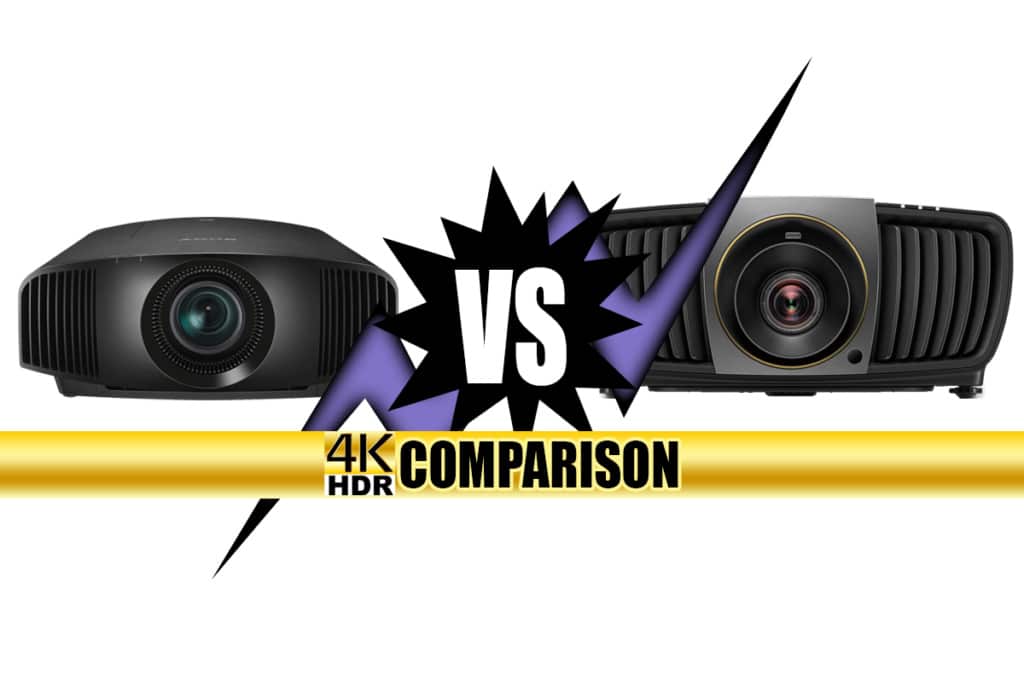AV Solutions, Home Theater
Sony VPL-VW295ES vs BenQ HT9060 (Part I)
Sony VPL-VW295ES /695ES and BenQ HT9060 Projector Comparison
Last CEDIA, (Sept. 2018) Sony introduced their 3rd generation of native 4K (4096 X 2160) projectors. The demonstrations and limited comparisons showed significant improvements to both black levels and HDR brightness. It was with much anticipation we looked forward to this comparison with BenQ’s 2nd generation pure LED, which promised up to 98% of DCI P3 within the 4K HDR spec of BT2020. Because of the pure LED, it could go a long way to adding the real value of HDR besides its dynamic range potential. We had also heard and read much about the BenQ’s all glass, super sharp, ultra low aberration lens and were anxious to see how the Sony and BenQ compared in image sharpness and detail. We also heard the BenQ blacks were not all that great and wanted to see just where they fell.
Since these mid-range projectors are all getting so good now, we decided to go a little deeper into the key differences in hopes that it would assist you, our customers, in making the best decision for your own theaters. Most of the images you will see in this blog were taken during the comparison and some were not used in the video, as we ended up with way more material than we could fit in the new HDR 4K online comparison YouTube video. To best understand these projectors, without seeing them in person (you are always welcome to drop by our facility here in Salt Lake City and we can show you live), it might be very helpful to both read this blog and watch the new comparison on YouTube.
The Projectors
| VPL-VW295ES/VPL-VW695ES | HT9060 | |
| Image Type: | 3 x .74″ LCD (SXRD Reflective) | .67″ DLP (HLD LED) |
| Resolution: | True 4K (4096 x 2160) | 4K UHD (3840 x 2160) |
| Lumen Brightness: | 1500/1800 | 2200 |
| Dimensions: | 19.5″ x 8.09″ x 18.25″ | 18.53″ x 8.85″ x 22.23″ |
| Weight: | 31 lbs. | 40.8 lbs |
| Typical Price: | $4,999/$9,999 | $8,999 |


Even though this is a third generation design, in essentially the same case and same second generation lens introduced in the VPL-VW285ES and VPL-VW385ES in 2017, it now has full 18 Gbps HDMI inputs, improved blacks, and HDR. Fan noise is a very low 23-26 dB in low mode, and still very quiet 32-34 dB in high fan mode from our measurements. In most home theaters, fan noise will not be an issue as 30 dB is considered whisper quiet. Both models are lamp-based with lamp life of up to 6,000 hours in low mode, and 4,000 hours in high mode. Size is manageable in most cases and the full lens shift, both horizontally and vertically, allows simple mounting options and installation. Sony continues with 3D in HD modes, a very respectable gaming mode for reasonably fast lag times, and a full motorized lens on both versions. If you do want lens memory for CinemaScope screens you can move up to the VPL-VW695ES which also gives you a dynamic iris for better blacks and contrast and an extra 300 lumens that you may want for a more compelling HDR experience or a larger screen size.
The first question some people ask when they first see the BenQ is, “why so large?” From what we can tell, there are two good reasons. One is the larger mass allows better heat dissipation so the fan noise is even lower by 3 or 4 dB than the Sony. Second, it shares a similar chassis with it’s classroom cousin, the LK990 6,000 lumen version. The lens and color are what attracted us to test this projector. The light source is pure RGB LED which allows the projector to claim 98% of the DCI P3 color space inside of BT2020, which at a decent brightness would be incredible for a commercially produced projector. Even the $35K solid state projectors from Sony and JVC do not do more than DCI P3 color space. In addition, the lens is claiming to be an all-glass, 14 element, low dispersion coated lens with little or no color aberration (color fringing).
Brightness
Before we can measure brightness, we must first do two things. The first is to make sure both projectors are at, or close to, D65 white point, which is the basis for all cinema color balance. The second, is to make sure that both projectors are able to reproduce the details in the higher levels. This is accomplished with a test pattern that shows the highlight clipping in the brighter white of the image as can be seen below.

Since the BenQ HT9060 is rated at 2,200 lumens, the Sony VPL-VW295ES at 1,500, and the VPL-VW695ES at 1,800, we were anxious to see where these would measure once they were calibrated. After we had both projectors in full brightness mode with HDR calibration we proceeded to measure their brightness. What we found was a surprise – but not really once you learn how manufacturers rate their projectors. The Sony measured 49.3 footcandles(fc) and the BenQ measured 43.7fc. The reason the BenQ dropped in brightness was because we had calibrated it to D65 and adjusted the contrast to get the best HDR image. The Sony also needed some adjustments, but was much closer right out of the box. The BenQ can reach its stated 2,200 lumens, but not in HDR accurate color. Even though the BenQ dropped significantly, as we will see on HDR and color tests, it still has a very bright and colorful image, and a few footcandles is not significant as you will see. As a reminder, the Sony 695ES is rated 300 lumens more than the VPL-VW295ES – so at least in theory it should be brighter than either of these projectors, or at least with a new lamp it should be. Note: all lamp-based projectors drop in brightness by as much as 25% during the first 150-200 hours. Solid state projectors do not significantly change over 1,000 hours and lose very little brightness and color balance.

As you can see from the above, it is much easier to reach a higher brightness if the projector is not calibrated to D65. To see what this would look like on an actual image, we played some of the reference images on the Spear and Munsil calibration disc. As you can see, it may be watchable in a lighted room for sports, but not very realistic to watch a movie in this mode. The Sony, again, measured about 49fc and the Ben Q measured 80fc in this bright mode.

Black Levels and Contrast
Sony and JVC are both known for having some of the best blacks in the home theater world. Both use 3 reflected LCD type chips generally referred to as LCOS (Liquid Crystal on Silicon), Sony’s is called SXRD, and JVC’s is called DLA. This technology, when properly applied, is hard to beat in terms of black levels. Before LCOS there was DLP (Digital Light Processing), like that used in the BenQ. DLP has inherently good contrast and very respectable black level capability. Almost 90% of commercial theaters use projectors with DLP chips, but with a significant difference: most commercial DLP projectors use 3 DLP chips in each projector. Most home theater DLP projectors, like this BenQ, use a single chip and derive their color by using a spinning wheel, or in the case of this BenQ use a sequencing of the 3 LED light sources. Getting good black levels in both cases are the result of good light engine design, and light control of the final output, either with an iris or controlling the light source itself (light dimming).

Before we can actually compare and measure black levels, we need to make sure both projectors are set properly so we are not crushing or reducing the detail in the dark parts of the image. This is done by using the appropriate test signal like the one above. Most projectors out of the box, we are finding, are not set up properly for best HDR images as they are sacrificing low light detail in order to achieve better blacks. In this case both the Sony and BenQ had to have their black levels increased to enable detail down to 0 IRE. Black levels are adjusted with the brightness settings in the image menu. Once both were set up properly, we got a reading of .02fc for the Sony, and between .03 and .04fc for the BenQ.
The Sony VPL-VW695ES would have done even better, and from our previous test with its predecessor, the 385ES, the addition of the iris would yield an improvement in black levels of at least .01 fc, or possibly even slightly better. However, it should be noted that this becomes a very delicate balance between the detail in the blacks and the operation of the iris. That is because as the iris reduces the black level, it also reduces the detail brightness. In other words, with darker blacks comes darker detail, and if you then raise the brightness up to compensate for the lower level, you then raise the level of the deepest blacks. That is why some people are big fans of a dynamic iris and others simply do not like the effect the iris has on the image, and sometimes can even detect when the iris changes, resulting in a brightness change that is distracting in the image. In the case of the Sony iris, they have developed very good control and the changes in brightness are usually not very noticeable. In this case, the really good blacks of the Sony are somewhat compromised if you want to see and enjoy all of the low level details in a scene. We found this not to be the case for non-HDR sources, like with regular Blu-ray, as they are able to keep both their blacks and low level detail as non-HDR sources do not have all the lower (and higher) level details to begin with.

The Sony VPL-VW695ES would have even better blacks, but as discussed above, the brighter parts of the image would also be less bright due to the lowering of the light output. When it comes to SDR (Standard Dynamic Range) like that used for TV and Blu-ray, it is a slightly different comparison. Here, the Sony’s have a more significant difference due to their very low black levels, and without the HDR requirement they do not need to reproduce (because they are not there in the source) all the very low level details.


Without question, in SDR (such as Blu-ray and TV) the Sony’s has a clear advantage in the very best blacks in the darkest of scenes. If you have the BenQ or want to improve your blacks on a scene like this, you may want to consider a high ambient light screen, such as a SI Slate, which can improve the blacks without losing all the good highlights. Also, watch the section, “Black Levels and Screen Types,” in the new Sony / BenQ comparison video, that will be released on YouTube as soon as it is done processing by Youtube (we’re finding it takes a lot longer to render 4K HDR content!), for a demonstration of how this works.




Thank you for the information. It was really helpful.!!
You’re welcome – glad you found it helpful!
Keep us in mind with your next projector purchase!